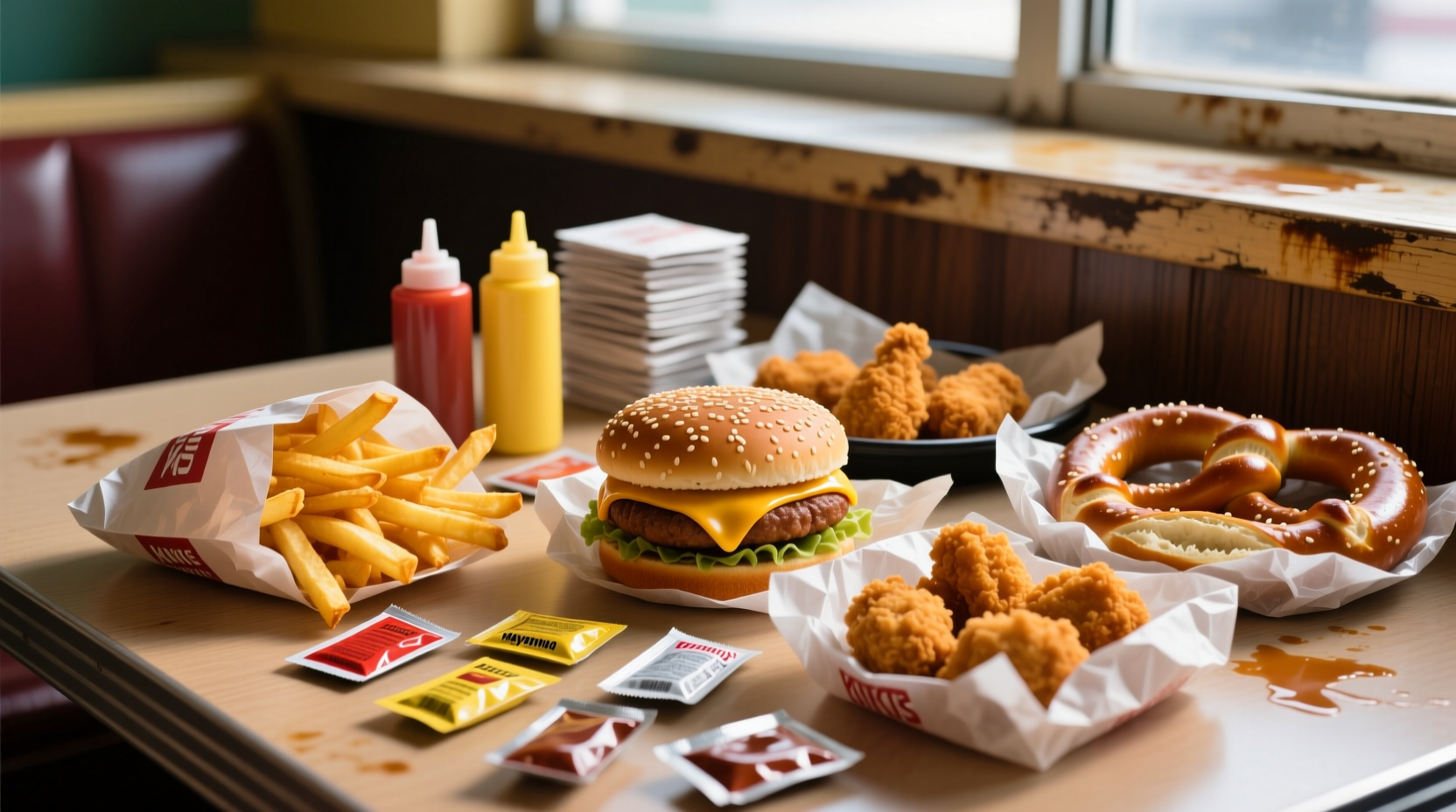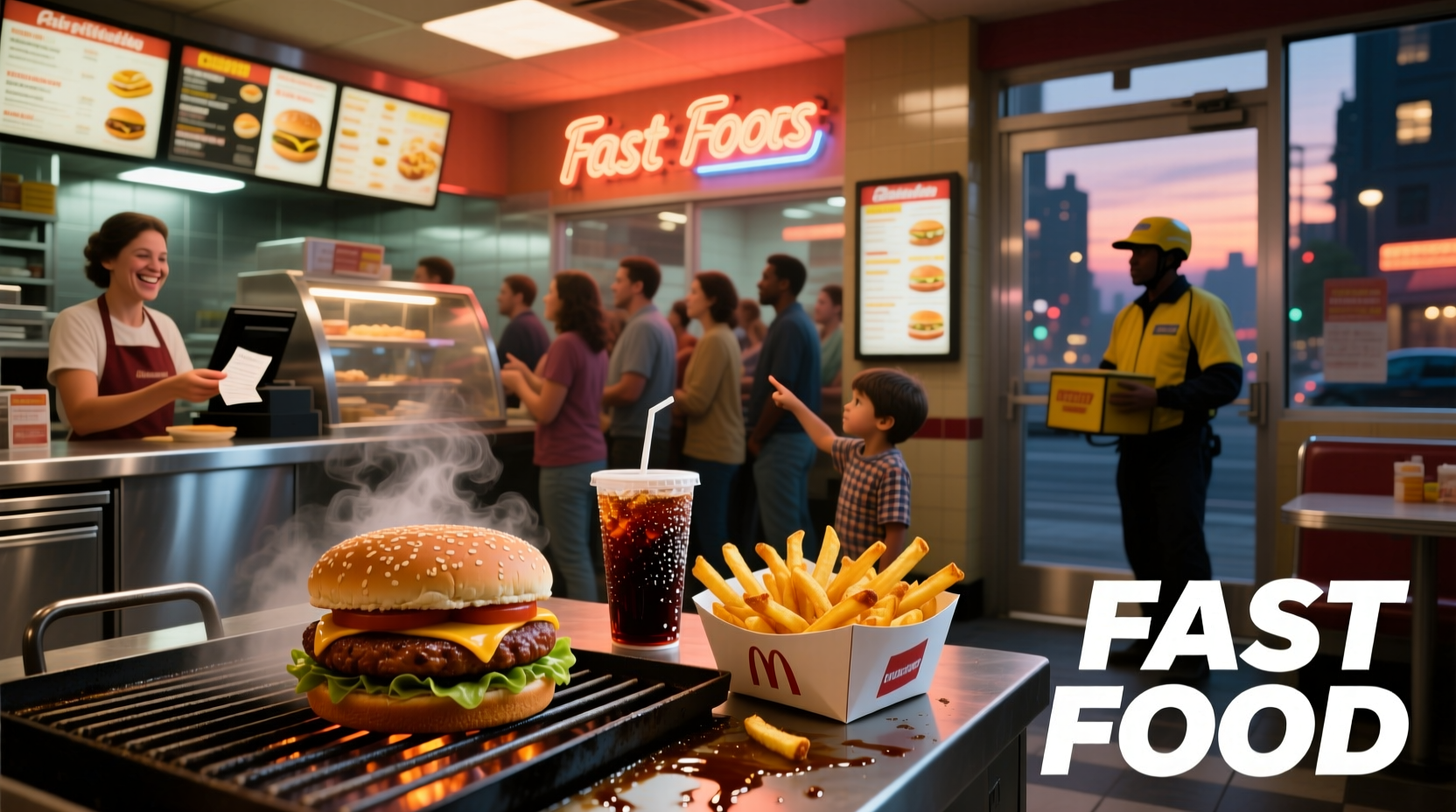Understanding Fast Food: More Than Just Quick Bites
When you search what is fast food, you're likely looking for a clear definition that separates it from casual dining or home cooking. This guide delivers exactly that—plus the historical context, nutritional realities, and global variations you need to understand this $660 billion industry shaping modern eating habits worldwide.
Core Characteristics That Define Fast Food
Fast food isn't just "food you eat quickly." It's a specific food service model built on four non-negotiable pillars:
| Defining Feature | Fast Food Standard | Traditional Restaurant Comparison |
|---|---|---|
| Preparation Time | Under 5 minutes from order to service | 15+ minutes typical service time |
| Menu Consistency | Identical items across all locations (e.g., McDonald's Big Mac) | Menu variations by chef/location |
| Service Model | Counter service, self-service, or drive-thru | Table service with dedicated waitstaff |
| Food Production | Pre-prepared components assembled to order | Cooked from scratch per order |
This standardized approach enables the industry's signature speed while maintaining consistent taste profiles nationwide—a critical factor distinguishing true fast food from quick-service restaurants that prepare items à la minute.
How Fast Food Evolved: A Historical Timeline
The concept of quick-service meals didn't emerge with the golden arches. Its development reflects changing American lifestyles:
- 1921: White Castle becomes America's first fast food chain, introducing standardized hamburger production in Wichita, Kansas
- 1948: McDonald's brothers revolutionize the industry with their "Speedee Service System" eliminating carhops
- 1955: Ray Kroc franchises McDonald's nationally, establishing the modern fast food template
- 1960s: Drive-thru windows become standard, aligning with America's car culture (USDA Food Safety and Inspection Service)
- 1970s: Global expansion begins with McDonald's entering international markets
- 2000s: Digital ordering and delivery apps transform the industry's accessibility
This progression shows how fast food adapted to technological advances and shifting consumer demands—moving from simple roadside stands to today's app-based ordering systems that now account for 30% of industry sales according to Technomic's 2023 report.
Recognizing Common Fast Food Categories

While burgers dominate perceptions, fast food encompasses several distinct categories:
- Burger chains: Focus on sandwiches with standardized recipes (McDonald's, Burger King)
- Taco specialists: Mexican-inspired quick service (Taco Bell, Del Taco)
- Fried chicken outlets: Pressure-cooked poultry specialists (KFC, Chick-fil-A)
- Pizza delivery: Pre-made bases with rapid assembly (Domino's, Pizza Hut)
- Coffee/snack shops: Grab-and-go beverage-focused models (Starbucks, Dunkin')
Each category maintains the core fast food principles while specializing in specific food types—a strategy that has enabled the industry's remarkable diversification while preserving its fundamental service model.
Why Fast Food Became a Cultural Staple
The industry's explosive growth wasn't accidental. Three converging factors created perfect conditions for fast food dominance:
- Economic efficiency: Standardized production cuts costs—making meals affordable for budget-conscious consumers (average $8.50 per meal according to IBISWorld)
- Time constraints: 72% of Americans cite "lack of time" as their primary reason for choosing fast food (Pew Research Center 2023)
- Consistency expectation: Modern consumers demand identical experiences across locations, which fast food reliably delivers
These factors transformed fast food from a convenience into an expectation—particularly valuable for families, travelers, and workers with limited meal breaks. The model's adaptability explains why 92% of Americans consume fast food annually (CDC National Health Interview Survey).
Nutritional Realities and Contextual Considerations
While fast food gets criticized for nutritional content, context matters significantly. Understanding appropriate usage scenarios helps make informed choices:
- Appropriate contexts: Road trips, emergency meals, time-pressed situations where cooking isn't feasible
- Limitations: Not suitable as primary nutrition source due to typically higher sodium, saturated fats, and calories per serving
- Smart selection: Many chains now offer grilled options, salads, and customizable nutrition information (per FDA Menu Labeling Rule)
The key isn't eliminating fast food entirely but understanding its proper place in a balanced diet. As Harvard T.H. Chan School of Public Health notes, occasional fast food consumption fits within healthy eating patterns when balanced with nutrient-dense meals.
Global Fast Food Adaptations
Fast food's success isn't limited to America. The industry demonstrates remarkable cultural adaptability:
- Japan: Teriyaki burgers and rice-based meals at McDonald's
- India: McAloo Tikki burger (vegetarian option) and masala-infused menu items
- Mexico: Breakfast menus featuring chorizo and jalapeño-infused items
- France: Higher-quality ingredients and wine options at quick-service locations
This localization strategy—maintaining core operational principles while adapting flavors—explains why global fast food revenue reached $920 billion in 2023 (Statista). The industry's ability to respect cultural preferences while delivering consistent service standards represents its most impressive evolutionary achievement.
Frequently Asked Questions
What legally defines fast food in the United States?
The U.S. Census Bureau classifies fast food establishments as NAICS code 722211: "Limited-Service Restaurants" characterized by counter service, no table service, and rapid preparation. These differ from full-service restaurants (NAICS 722511) which provide table service and longer meal durations.
How does fast food differ from casual dining?
Fast food features counter service, disposable packaging, and preparation under 5 minutes, while casual dining provides table service, reusable dishware, and meal preparation typically exceeding 15 minutes. Fast food menus maintain strict national consistency, whereas casual dining often allows regional menu variations.
Are all drive-thru restaurants considered fast food?
Not necessarily. While drive-thru is common in fast food, some establishments like certain coffee shops or frozen yogurt places offer drive-thru but lack other defining characteristics such as standardized nationwide menus and rapid assembly of pre-prepared components. The presence of drive-thru alone doesn't qualify a restaurant as fast food.
Has fast food nutrition improved in recent years?
Yes, significantly. Since 2010, major chains have reduced sodium by 15%, eliminated trans fats, and introduced more vegetable options according to a University of Cambridge 2022 industry analysis. Many now provide detailed nutrition information and customizable options to accommodate dietary needs, though calorie density remains higher than home-cooked meals on average.











 浙公网安备
33010002000092号
浙公网安备
33010002000092号 浙B2-20120091-4
浙B2-20120091-4